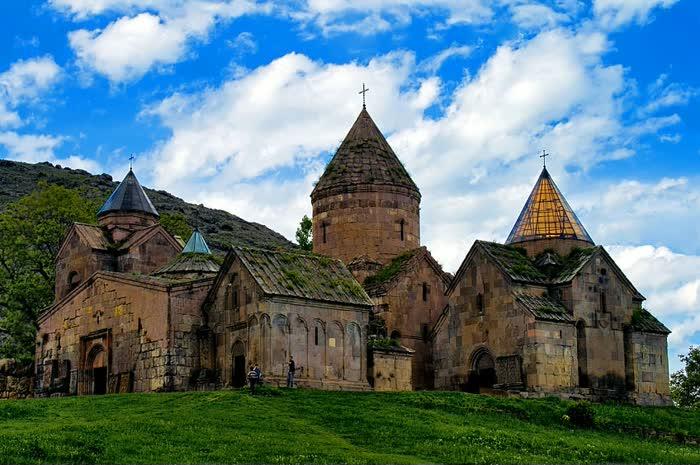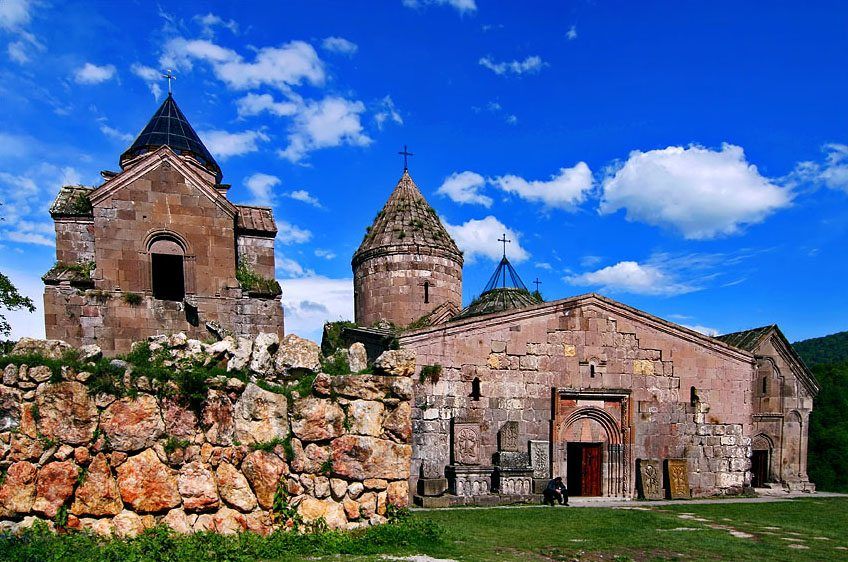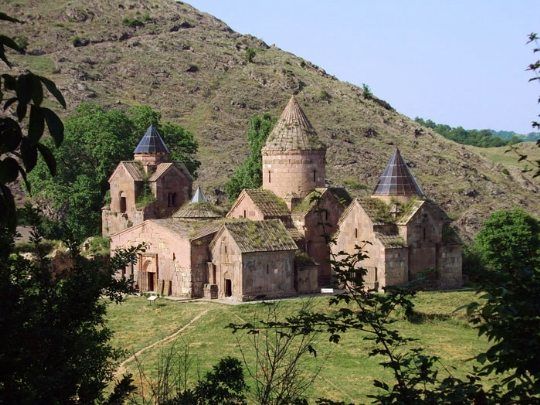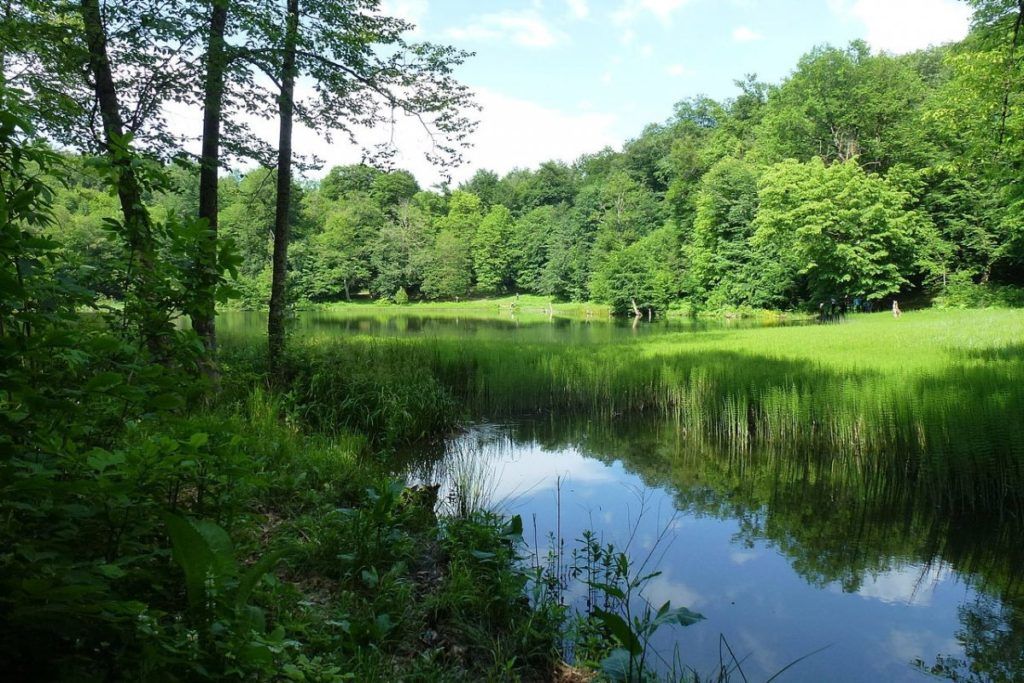Nor Getik Monastery or Goshavank is a popular religious and cultural centre of northern Armenia. It’s situated in Ijevan, village Gosh. There are many forests and hills around the monastery. Unlike other monasteries of middle ages, the chronology and history of Goshavank we can know from not only popular historian Kirakos Gandzaketsi’s “Patmutyun” work, but also from inscriptions on the walls of the monastery.
Nowadays Goshavank is not a functioning religious complex, it remains a tourist destination. Lately, it is under restoration. Though it’s a bit incomprehensible, an Islamic individual from the United Arab Emirates finances the restoration. The monastery is also one of the world’s finest examples of khachkar.
The Name of Goshavank
According to the “History” of Kirakos Gandzaketsi, the construction of the monastery belongs to Vardapet, scientist, jurist and prose writer of seventh century Mkhitar Gosh (Gandzaketsi, Getiktsi).
Since his childhood, Mkhitar Gosh studied Holly Book. Then he was a student of Hovhannes Tavushetsi. After finishing his studying he got a degree of Vardapet. Gosh wanted to deepen his knowledge, so he entered the popular religious scientifical school of Sev Ler in Kilikia hiding his degree of Vardapet. He learnt more and went back to Armenia with a rich knowledge.
In 1177, while he was coming back to Armenia, Mkhitar met a prince and Amira of Tiflis Amir Kurd. King Georgy III of Georgia had relegated Amir Kurd. Later he helped Mkhitar in his scientifical and structural activities. His scientifical activities Mkhitar started in Khachen, in Horomashen Monastery. This was the place where Mkhitar came up with an idea of writing his popular “Datastanagirq”.
After the death of Georgi III, his daughter Tamar becomes a queen of Georgia (in 1858). She lets Amir Kurd enter Karin. Mkhitar also moves to here and stays in Getik Monastery. In this monastery, he creates a number of works. Soon an earthquake destroys Getik Monastery. Mkhitar Gosh with the help of Kurd Artsruni asks his cousins Zaqaria and Ivane princes to give him a new place for rebuilding the monastery.
The Reconstruction of Getik
Zaqaryan princes appreciate Mkhitar’s request and give him Tandzuta canyon.
Mkhitar gathers all the scholars of destroyed Getik and asks them to help him to re-establish Getik. So after reconstruction of the Monastery they called it Nor Getik (New Getik).
Later the constructions work Mkhitar’s pupils continue, especially Martiros Vardapet. During the guidance of Martiros, in 1237, Grigor Tgha prince establishes a church with three sanctuaries.
The last building of monuments group of Nor Getik is the Belfry with the names of Gabriel and Michael archangels. Dasapet Vardapet and his brother Karaped established in 1291.
About the Construction of Nor Getik
As it is obvious from aforementioned, in Nor Getik monastery the construction was started in the seventh century and ended in the end of the nineteenth century. For a whole century, there was a brisk and productive construction, religious and cultural activity, which brought outstanding monuments of its figures. Those monuments got their honourable places in Armenian cultural treasury.
All the monastic buildings of Goshavank have lithographical memorials with different contents. Studying these memorials is very important for knowing history and social status, legal situation and culture of the century in details.
In the middle of the nineteenth-century topographians of historical Armenia in their compositions added lithographical manuscripts of Goshavank, and they elucidated the cultural and religious activities of the middle ages.
Shahkhatnyants and Jalalyants
Shahkhatnyants and Jalalyants were the first who described the buildings of Goshavank and published the lithographies on the walls of Goshavank. By the way, first one copied 3, and the second one 28 inscriptions. Then, at the end of the nineteenth century, Malkhasyants and Barkhudaryants introduce more remarkable and wider manuscripts of the monastery in their itineraries. At the beginning of the twentieth century.
Harutyunyan
At the beginning of the twentieth century, Harutyunyan published “Goshavank or Nor Getik” article in “Ethnographical journal”. In the article describing the monuments of the monastery and Mkhitar Gosh’s activities, he published 60 inscriptions, that he had decoded on his own.
Janpoladyan
In 1970s archaeologist and historian, Janpoladyan took Mkhitar Gosh’s scientifical-cultural activities and his established Nor Getik Monastery as a special subject for studying, copied and decoded the inscriptions of the group of monuments. Twenty-two of those inscriptions are in the collection of Armenian National Historical Museum. It’s worth stating, that Janpoadyan had the copies of Orbeli. Orbeli had given those copies of the group of inscriptions to him for checking and filing in.
Yeghiazaryan
Later, in 1959, in the “Ejmiatsin” journal, Yeghiazaryan published “The Monastery of Nor Getik or Goshavanq” article and described monuments and introduced 75 manuscripts of his own copies.
A Little More about Inscriptions of Goshavank
The interpretations of the lithographical manuscripts of Nor Getik are mainly published with many distortions, incomplete, without any picture or diagrams. And with such introductions, there is less possibility to make people believe their studies about Goshavank. Those manuscripts had no scientifical and critical discussion. In “Divan Haykakan Vimagrutyun” book you can find the pictures and more information for the first time.
The inscriptions od Nor Getik Monastery are interesting for their old writings and the way of drawings. Those inscriptions we can divide into three parts, inscriptions, that:
- were drawn on a glittering stone, using mainly red and black colours.
- at the beginning were in the paint, later for making more long-lasting they engraved on it.
- after being engraved they painted.
A considerable number of the inscriptions is a donation. Also, there are structural, licensed, Memorial manuscripts.
Gosh Village
Gosh is a village in Tavush province, in the valley of Gosh river. It’s far from Yerevan by 118 km.
The History of the Village
Gosh village was established in 1840-1845. The first residents were previous villagers of Dostlu and Kot villages. As an old place, its existence comes from 10-11 centuries.
The Tradition
As you could understand, this is the village where lived Mkhitar Gosh and where he established Goshavank.
According to the tradition, one day Mkhitar in his dream saw, that God told him that for seven years there will be plenty of bread, and for seven days there will be rainless. Later God told him to gather store for the rainless period so that people don’t have difficulties.
Gosh did how he saw in his dream. He bought flour with the means of the monastery and kept it in granaries. When famine entered in the village, he made a big wooden container and with shared flour to the people.
When Mkhitar died people called the village by his name Gosh.












Leave a Comment